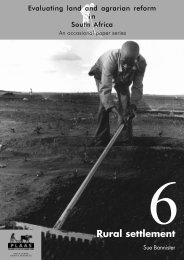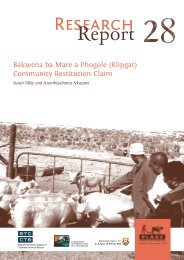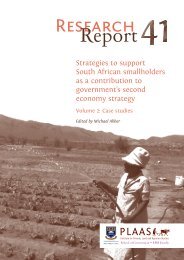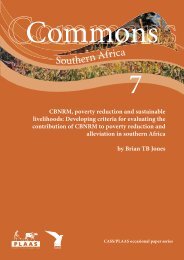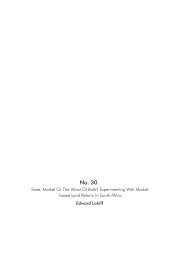Create successful ePaper yourself
Turn your PDF publications into a flip-book with our unique Google optimized e-Paper software.
PublicationsMunicipal Commonage –How to Access and Use It!The Legal Resources Centre and the TCOEreleased a booklet discussing:• the history of municipal commonagesin South Africa;• opportunities municipal commonagescan create for land reform and ruraldevelopment;• the rights of poor town residents(who were excluded from municipalcommonages under apartheid) toprevent municipalities from sellingmunicipal commonages and to accessthem to supplement livelihoods;• the relevant municipal laws and thenational legal and policy frameworkthat permit the DRDLR to grant fundingto municipalities to buy land to extendexisting commonages or establish newones;• how to establish infrastructure, planand implement projects and do audits.The main aim of the booklet is to help‘previously disadvantaged’ town residentsto mobilise to access municipal commonagesfor agricultural production.This publication is available from LRC http://www.lrc.org.za/booklets/1243-municipalcommonageand TCOE offices.The Land Tenure LawAshraf Mohamad of Cheadle, Thomson& Haysom Inc. under the auspices of theDepartment of Rural Development’sLegal Services Project of the Land RightsManagement Facility. Juta.This book covers complex legal issuesrelating to land tenure law, includingthe Labour Tenants Act 3 of 1996, LabourTenancy Arbitration Rules, Extension ofSecurity of Tenure Act 62 of 1997, andthe Regulations under the ESTA and thePrevention of Illegal Eviction From andUnlawful Occupation of Land Act 19 of1998. The book explains key definitions inthe law and provides practical guidelineson land rights disputes. It also explainsrelevant case law in accessible languageand sets out the nature and scope of legalprotection available to land occupiers andlabour tenants, with a section on access tothe courts, including the Land Claims Court.The book also includes a bibliography oflocal and international publications on landtenure.Working Paper 11. A Fieldnot Quite Her Own –Single Women’s Access toLand in Communal Areasof Zimbabwe.Gaynor ParadzaDominant arguments about women’s landaccess stress the vulnerability of singlewomen’s land rights in customary tenure areas.The vulnerability is based on long-heldassumptions about customary tenure landgovernance, land use and gender relations.The paper – the first in a series looking atsecured access to land for poor women insouthern Africa – contributes to the debateon customary area land access, landlessnessand understanding customary tenure evolution.Although single women have increasinglyinsecure tenure on customary tenurelands, spaces do exist in those systems forsingle women to negotiate access to land.Such spaces remain hidden in customarytenure analysis that focuses on the primary–secondary rights dichotomy and the use ofland as an agricultural asset. Drawing oncase studies of 22 women in a customarytenure area in Zimbabwe, the paper showsthat although resource governance systemsin customary tenure areas are male-biased,more diverse access opportunities exist thanpreviously thought and single women havesome room to manoeuvre. Visit http://www.landcoalition.org/sites/default/files/publication/954/WLR_11_Gaynor_A_field.pdfWorking Paper 12.Differentiation ofWomen’s Land TenureSecurity in SouthernAfrica.Gaynor ParadzaThe comparison of women’s land access ispredominantly measured against that ofmen, and this has been the basis for formulatingpolicy aimed at increasing women’sland tenure security. However, this dichotomyreduces women to a homogeneousgroup that experiences tenure security inan identical manner, so masking severaldifferences which exist among women. Afocus on the differences among women allowsfor significant insight to emerge intohow women experience tenure and accessdifferently, how various policies impact ondifferent women, and the specific waysthese differences could be used to informpolicy formulation and evaluation. Focusingon differentiation among women alsoillustrates other important factors shapingwomen’s access to land – factors that aregenerally overlooked when research focuseson differences between men and women.This paper highlights how differentiationis useful to explain women’s differencesin land access and how policy aimed at ensuringwomen’s tenure security could bemore effective. Visit http://www.landcoalition.org/sites/default/files/publication/955/WLR_12_Gaynor_Differentiation.pdf for afull copy of the working paper.International land Coalition (ILC)A bulletin tracking land reform in South Africa January 20115






